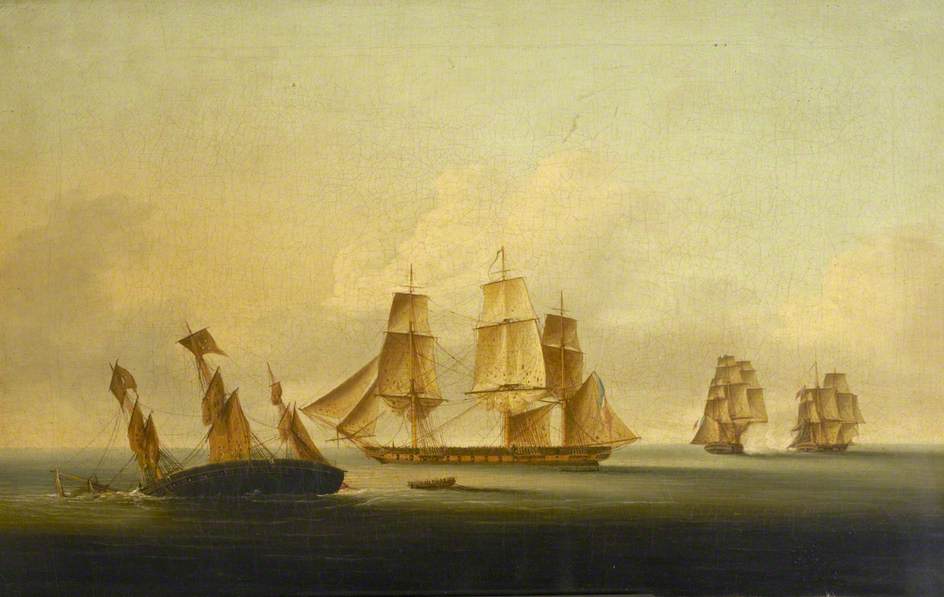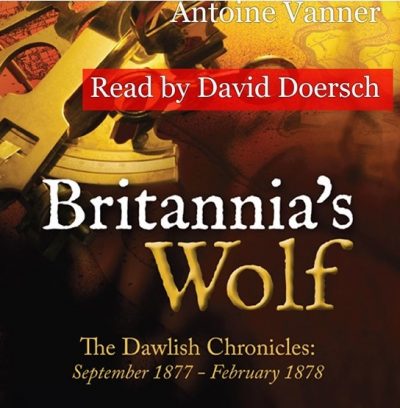An epic last stand – HMS Acheron and HMS Arrow, 1805
In a separate article we encountered the innovative sloop, HMS Dart, when she went into attack on the heavily defended French base at Dunkirk in 1800 (Click here for this article). HMS Dart and her sister HMS Arrow, were experimental vessels, never indeed to be repeated. They were the brain-child of Sir Samuel Bentham (1757 – 1831) – brother of the philosopher Jeremy Bentham. At this stage in a remarkable career as an engineer and naval architect, in Britain, Russia and China, Sir Samuel held the position of Inspector General of Naval Works. These two vessels were virtually double-ended and featured a large breadth-to-length ratio, structural bulkheads, and sliding keels. Of 150 tons and a mere 80 feet long overall, they packed an enormous punch for their size, all guns being carronades, twenty-four 32-pounders on the upper deck, two 32 pounders on the forecastle and another two on the quarterdeck.

 Close up of HMS Arrow – detail from larger painting shown below
Close up of HMS Arrow – detail from larger painting shown below
The second of the sister-vessels, HMS Arrow left Malta in January 1805, under the command of Commander Richard Vincent (1770–1831), to escort a British convoy of 34 merchant vessels headed westwards out of the Mediterranean. Accompanying her, as the only other escort, was HMS Acheron, commanded by Commander Arthur Farquhar (1772 – 1843). The latter was somewhat of an unusual choice, as she was a bomb vessel, a 388-ton, 108-foot merchant ship that had been converted to carry a 10-inch mortar and a massive 13-inch weapon for shore bombardment. Though these mortars were unsuited to ship-to-ship action, HMS Acheron did however carry a heavy close-range armament of eight 24-pounder carronades. Once again, as we see in so many accounts of actions in this era, the carronade was to provide unexpectedly strong gun-power to a small vessel.
The convoy had passed out into the Atlantic through the Straits of Gibraltar when on the morning of 3rd February two large vessels were seen coming up fast from astern. These were initially thought to be laggards from the convoy but as they closed they were perceived to be most likely warships. Commander Vincent on HMS Arrow accordingly signalled to HMS Acheron to investigate. The strangers proved to be powerful 40-gun French frigates, later to be identified as the Hortense and the Incorruptible. Neither HMS Arrow nor HMS Acheron could be considered a fair match for either. A stern chase developed and continued through the day but by nightfall it was obvious that there would be no way of escaping. The options were to fight or to surrender. Commander Vincent chose to fight.

 French frigate Incorruptible
French frigate Incorruptible
It appears that Vincent had previously made an agreement with the captains of the larger merchant ships in the convoy that carried guns to form a line of battle in such circumstance. He now called on them to do so but according to one account “these gentlemen were of the opinion that discretion was the better part of valour… they did not even answer the signal.”
Darkness had now fallen, so too the wind, and no contact were made with the enemy during the night. A breeze sprung up with first light the following morning however and one of the French frigates was revealed to be close enough to hail HMS Arrow. Vincent was invited to submit and come on board the French vessel but he replied with a similar request. The French now opened fire on both HMS Arrow and HMS Acheron and it was returned. This fire-fight was not intense until full daylight would allow more accurate shooting. At seven o’clock the real action began – one can imagine the preparations on all the ships during the three or so hours immediately prior to this, and the sense of supressed fear that must have reigned among the crews.


Opening of action: on left Acheron takes on Incorruptible and on right Arrow engages Hortense – by Francis Sartorius Jr. (c) National Maritime Museum; Supplied by The Public Catalogue Foundation
Both British and French vessels opened fire almost simultaneously. The Hortense concentrated on HMS Arrow while her sister Incorruptible focussed on HMS Acheron. The wind was so light that the vessel had difficulty in manoeuvring but the unequal contest continued regardless for an hour and twenty minutes. HMS Arrow sustained massive injury – her masts and rigging badly damaged, four guns dismounted on her engaged side, her rudder rendered inoperative. Most serous of all was however that she had taken many hits “between wind and water” – that is, on her hull below the water line as it was exposed by rolling. Out of some 132 on board (including several passengers, among them a lady, her baby and her maid) thirteen men had been killed and twenty-seven wounded, a casualty rate of 30%. Commander Vincent realised that further resistance was futile and he struck his colours in surrender. HMS Arrow was so badly damaged that French boats were sent across to take off the survivors, her own boats having been so badly damaged. The transfer was just completed when HMS Arrow rolled over on her beam ends and disappeared.
HMS Acheron had been in action against the Incorruptible all this time and had suffered severe damage, but low casualties. She resisted for a quarter hour longer than HMS Arrow but in the end the Acheron’s Commander Farquhar reluctantly ordered his colours to be struck as well. She was so badly disabled that the French set her on fire after her crew had been taken off.

HMS Arrow sinking after surrender, HMS Acheron and Incorruptible still engaging on the right – by Francis Sartorius Jr. (c) National Maritime Museum; The Public Catalogue Foundation
The behaviour of the French officers and men to their captives offers significant insights to the state of discipline and morale in Napoleon’s navy at this time. On board the Hortense the conduct of the officers was “polite and humane” but they had so little control over their crew that they were unable to restrain them from pillaging the British prisoners. The treatment of the prisoners was even worse on the inappropriately named Incorruptible, the officers themselves “taunting them with their misfortunes, using very opprobrious terms.”
The sacrifices of HMS Arrow and HMS Acheron bring to mind similarly doomed resistance by the armed merchant cruisers HMS Rawalpindi and HMS Jervis Bay in 1939 and 1940 when they too were faced by overwhelming enemy force while escorting convoys. In all these cases the “last stands” by the escorts allowed a substantial part of the convoy to escape. After the Arrow and Acheron action the French frigates captured only three out of the 34 ships in the convoy. Some of these vessels, now sailing independently, did however later fall prey to Spanish privateers.
HMS Acheron’s crew was taken to Malaga and, as was common at this period, a prisoner-exchange deal was agreed soon after. Commander Farquhar, his officers, and his crew were court-martialled on board HMS Royal Sovereign off Sardinia for the loss of their ship. The court-martial was a formality – Farquhar was not only acquitted with honour but he was promoted to the coveted rank of Post Captain. The court-martial president returned Farquhar’s sword with the words “I hope you will soon be called upon to meet the Hortense on more equal terms. The result of the contest may prove more lucrative to you, but it cannot be more honourable” (What a wonderful way with words!)
The Arrow’s crew were taken to Cartagena and were exchanged some three months later. Their court-martial took place on board HMS Gladiator in Portsmouth and Commander Vincent and his men were acquitted with similarly eulogies to those accorded the Acheron’s crew. Vincent too was promoted to “post”.
A pleasing postscript was the two ships’ defence of the convoy was rewarded by commercial organisations. Swords of Honour were presented to both Vincent and Farquhar by the Lloyds (Insurance) Patriotic Fund and cash payments were made to wounded, bereaved families and survivors who had lost all they had when the vessels were destroyed.
Looking back over two centuries however, the most significant aspect of the action was the post-victory behaviour of the French crews and the inability of their officers to control them. It was hard to imagine such men ever prevailing against the discipline and professionalism of Royal Navy crews. And Trafalgar, only eight months later, proved that they could not.
Britannia’s Wolf is the first in the seven-book Dawlish Chronicles series (with the eighth due in December 2019)
 1877: the Russo-Turkish War is reaching its climax.
1877: the Russo-Turkish War is reaching its climax.
A Russian victory will pose a threat to Britain’s strategic interests. To protect them an ambitious British naval officer, Nicholas Dawlish, is assigned to the Ottoman Navy to ravage Russian supply-lines in the Black Sea. In the depths of a savage winter, as Turkish forces face defeat on all fronts, Dawlish confronts enemy ironclads, Cossack lances and merciless Kurdish irregulars, and finds himself a pawn in the rivalry of the Sultan’s half-brothers for control of the collapsing empire. And in the midst of this chaos, unwillingly and unexpectedly, Dawlish finds himself drawn to a woman whom he believes he should not love.
Neither for his own sake, nor for hers…
Britannia’s Wolf introduces a naval hero who is more familiar with steam, breech-loaders and torpedoes than with sails, carronades and broadsides. Dawlish joined as a boy a Royal Navy still commanded by veterans of Trafalgar but he will help forge the Dreadnought navy of Jutland and the Great War.
Further books in the series accompany Dawlish on that voyage into the future.
 In Audiobook format also…
In Audiobook format also…
Britannia’s Wolf is also available as an audio-book. It’s been read by the distinguished American actor David Doersch. If you haven’t previously ordered an audio-book from audible.com you can download it without cost as part of a 30-Day Free Trial. You can listen on your Smart Phone, Tablet or MP3 Player. Click here details or on cover image.
Registering for the Dawlish Chronicles mailing list by clicking on the banner below, will keep you updated on new books and facilitates e-mail contact between Antoine Vanner and his readers. You’ll also get five free short stories to load on your Kindle or Tablet.

